INNOVATION| 21.04.2021
NFT, the metaverse and what to expect from this technology

Esteban Viso
One of the on-trend acronyms in recent weeks is, without a doubt, NFT. Non-fungible tokens are the latest application in blockchain technology to arrive on the scene. And not without controversy. Some see them as a trap, while others see an opportunity. The truth? It’s hard to say, but we can start by understanding exactly what an NFT is.
Let’s start at the beginning: What is a token? This is a non-sensitive data element (i.e. it has no exploitable value) that contains a reference to sensitive content, which can only be accessed through the original tokenization process.
In short, a token is the equivalent of a “voucher for a…” when we want to give something to someone, who can redeem it at any time. So if we have a token that has the same value as a toaster, we can redeem it whenever we want for that physical object; if the token equals 0.001 bitcoins, its owner can redeem it at any time and will receive its current value in euros or dollars.
In the above example, the token is fungible because it can be exchanged for real money and therefore can be spent. This is not the case with NFTs, which never lose their value because they represent, or are equivalent to, an intangible asset.
So what is an NFT?
Anything we create and publish on the Internet is an intangible asset that can be associated with an NFT, an unchangeable token that serves as a certificate of authenticity. This means that we can represent a pixel art image, a digital animation, a monologue, a literary creation, a live broadcast… anything.
That “asset” (we’ll explain why we need to use quotation marks in a moment) will be associated with a blockchain transaction, which is usually Ethereum, but is starting to feature in other known strings.
NFTs are obtained by associating the asset with the blockchain, which is inevitably bound to that block. It can also be invaluable, or have no value. It all depends on one thing that we as human beings have practiced for hundreds of years: collectionism.

Seth Godin proposes a very precise definition:
What is an NFT? It’s a digital token (just as a bitcoin is a digital token) except that it’s singular and unique, like an Honus Wagner [a baseball player], there is only one. One of these tokens may refer to something else (a video of a basketball shot, an oil painting, even this blog entry) but it is not that thing. It is simply a file authorized by the person who made it to be the only one.
To understand NFTs, we must understand collectionism
We must understand what drives this desire that leads some people to want both possession of something and to spend thousands (or millions) of euros, and actually do so. It’s not easy to relate if we haven’t experienced it ourselves, and that’s why explaining NFTs is so complicated.
The most universal example of collecting is trading card albums. Children know that putting the entire collection together is difficult, because some trading cards are rarer than others. For example, a first-division player on a large team will be rarer than a bottom-league reserve.
This shortage causes these trading cards to progressively increase in value. The fewer “repeat” trading cards there are, the more valuable they are. Children will begin to offer higher amounts of lower-value alternative trading cards to be able to “acquire” the card they need to complete their collection. They could even offer an absurd amount of trading cards just to finish off the album. What does this feel like? The feeling of completeness, of owning something rare (or unique, in a more extreme scenario).
For this exact reason, the first tweet in history has been bought for almost three million dollars. Why? To be the only person in the world who owns it. And using that idea, we can think of several other examples like this. Or, to quote Enrique Dans:
Mike “Beeple” Winkelmann, who years ago set out to create a digital image every day, and who has now decided to put them all together, anchor them on Ethereum and sell that digital work at Christie’s in an auction that topped 69 million euros.

The value of NFTs is the therefore understood as certifying the creation of the digital item as “unique.” And that digital creation can be anything.
This explains why we gave the word “asset” quotation marks earlier in the article: the object associated with the NFT can become desirable by the collector community (of art, or anything) and a speculative spiral occurs whereby, under the right conditions, it can reach stratospheric amounts.
The metaverse and NFTs
Let’s delve deeper to explain the relationship between an NFT and the metaverse. For starters, a metaverse is an environment in which humans interact (socially and economically) through their avatars. In other words, in a virtual world (remember Second Life?) to which users connect, where a series of rules of participation are established in a type of real-world metaphor.
All without the limitations of our world. The novel “Ready Player One” presents a metaverse in a dystopian fantasy where the world’s population lives much of its existence within a virtual reality network, in which they have jobs, leisure time and everything they need to develop.
When we talk about NFTs and the metaverse, we have to go one step further. This is something that may confuse anyone not familiar with this small world, but this newsletter helps us to understand what’s beginning to happen (or the potential of combining the metaverse with NFTs):
A participant might walk through a virtual shopping mall and buy a digital Mickey Mouse costume in the Disney store for his avatar to wear, then pop over to the food court to pick something to eat to be delivered to his physical house via Uber Eats, and then pop into a live Beatles concert in the Spotify Performing Arts Center. He can keep the concert going in his AirPods on Spotify when he wants to go for a run in the physical world, racing against his friends […] The whole thing feels seamless: his data and purchases carry across and among physical and digital worlds.
This involves the actual transfer of resources (data, purchases) between two universes, the real and the virtual. Enter Web3, or the decentralized Internet, which is the key that can link NFTs with the metaverse and allow us (as some experts say) to enter a new world that is, to stick with the fantasy theme, a kind of copy of the world represented in Ready Player One.
